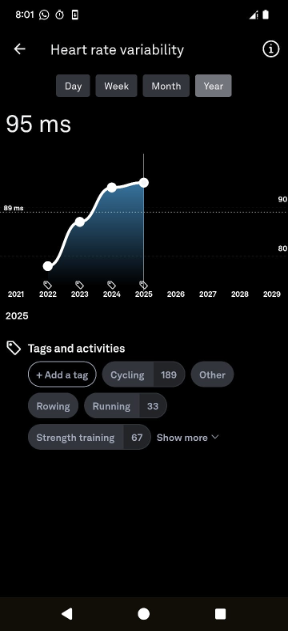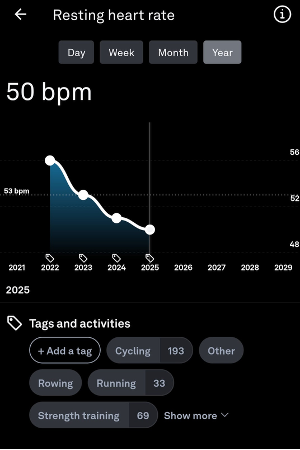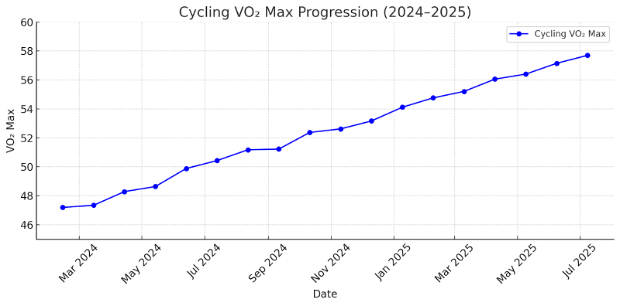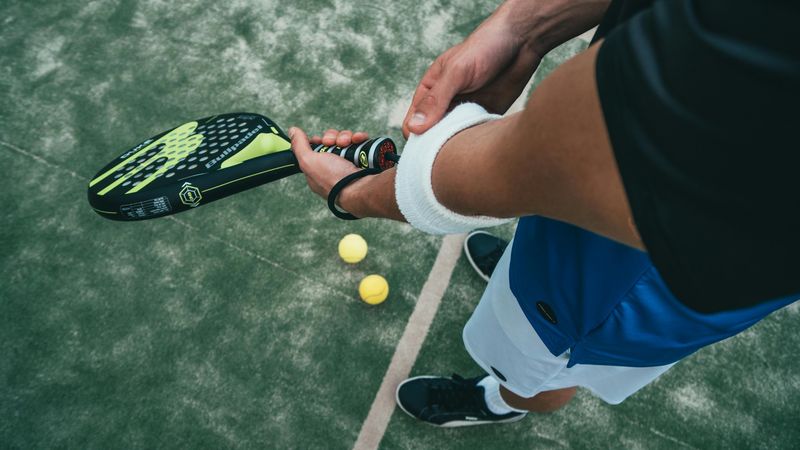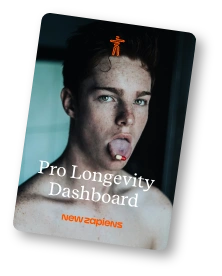Train smarter, recover faster: What HRV reveals about your body’s readiness, stress, and adaptation.
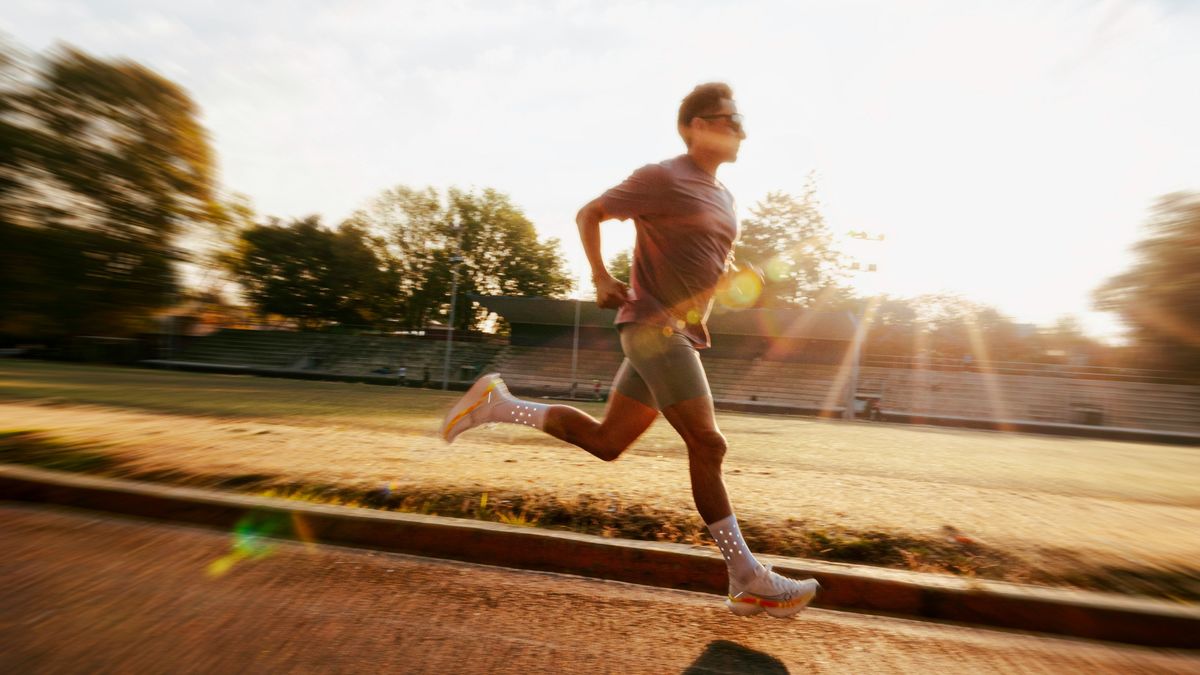
Imagine knowing exactly when to push harder in training - and when to hold back - so your body adapts instead of breaking down. That’s what heart rate variability (HRV) can offer.
I first heard about it 10 years ago when my school’s strength coach asked if there were devices to tell him when to rest his cricket fast bowlers before weekend matches. Back then, HRV tracking was rare and expensive, and I assumed it might be a gimmick. Years later, my first Garmin introduced me to the concept through its ‘Body Battery,’ and eventually, my Oura Ring showed me just how powerful HRV can be. Today, it guides my own training, helping me spot early signs of stress, overtraining, or illness. Over the past three years, my HRV has risen in step with my VO2 max, while my resting heart rate has fallen - supported by better training, less stress, and avoiding late eating. Together, these three markers point to greater resilience and recovery. The same principles that worked for me can help anyone build fitness more intelligently and sustainably.
I've included some screenshots of my data below. They tell the same story that the research community, and experts like Dr. Marco Altini, have been emphasizing: when you build aerobic fitness and recover well, the nervous system adapts in powerful ways. Increases in my VO2 max were strongly linked to my increase in HRV.
Most people hear about HRV through wearables or "readiness scores." They see a number go up or down and wonder if they should feel proud or worried. But HRV has a rich scientific history that predates fitness trackers by decades. And if you know how to use it properly, it can be a powerful tool to understand your body's response to stress and recovery - not just a metric to "maximize."
Much of what we know today about practical HRV use comes from Dr. Marco Altini, a data scientist and sports scientist, founder of HRV4Training, and advisor to Oura Ring. Altini has spent years bridging physiology and technology, publishing on HRV measurement protocols, HRV-guided training, and long-term HRV trends. This article draws heavily on his work and the research he has summarized.
A Brief History of HRV
HRV research began more than 50 years ago in clinical settings. Early studies used HRV to distinguish between health conditions; lower variability was linked with higher cardiovascular risk. Over time, sports scientists began applying HRV to training.
A pivotal 2007 study by Kiviniemi et al. introduced one of the first structured protocols for HRV-guided training:
- Train hard if HRV stayed normal or improved.
- Back off if HRV dropped significantly (below your normal range).
As Altini has noted in his blogs, athletes following this HRV-guided approach often trained less at high intensity yet improved VO2 max and performance more. Later researchers like Vesterinen and Javaloyes refined this with rolling 7-day baselines and normal ranges to avoid overreacting to daily fluctuations.
What is HRV, Really?
HRV stands for Heart Rate Variability - the variation in time between heartbeats. If your heart beats 60 times per minute, it's not one beat per exact second; the intervals vary. This variation is controlled largely by your autonomic nervous system (ANS):
- Sympathetic ("fight or flight") speeds heart rate.
- Parasympathetic ("rest and digest") slows heart rate.
HRV reflects the balance between these systems. As Altini emphasizes, HRV isn't about "high is good, low is bad." It's about context and how your HRV compares to your own baseline. Comparing HRV between people is meaningless.
The metric researchers rely on most is rMSSD, which reflects beat-to-beat parasympathetic activity. It's the same measure Altini uses in his HRV4Training app.
Why and How to Measure HRV Correctly
Altini's work stresses that HRV is only meaningful with proper measurement:
- Morning is best: Measure right after waking, before caffeine or activity.
- Position: Sitting or standing briefly adds a small "orthostatic" stressor that makes readings more sensitive. Research by Gregoire Millet's group, cited by Altini, shows lying-down or night-time wearable readings can miss subtle training or altitude stress.
- Consistency: Same time, same conditions daily.
- Duration: 1–2 minutes of stillness.
As Altini puts it: "Good data comes from good protocols, not overpriced toys packing distractions." Wearables aren't useless, but morning orthostatic protocols capture far more nuance.
What HRV Is - and Is Not
HRV is:
- A non-invasive marker of your autonomic state.
- Sensitive to stressors long before resting heart rate changes.
- A tool for awareness, not a scoreboard.
It is not:
- A direct measure of muscle recovery or soreness.
- A metric to "maximize." Research by Le Meur et al. shows abnormally high HRV can signal parasympathetic overreaching.
- Something to interpret without context. Pair it with subjective measures like sleep quality and soreness.
Using HRV: When to Hold Back and When to Push
The best-established use of HRV is knowing when not to add stress. If your baseline HRV (7-day average) drops below your normal range for several days - and you feel run down - Altini's recommendation is to reduce intensity. It's not that you can't physically complete a hard session; it's that your body is less likely to adapt well.
What about the flipside? In his blog "When to Hold Back and When to Push," Altini highlights research by Hautala (2003, 2008) and Vesterinen (2013):
Athletes starting overload periods with higher baseline HRV achieved greater aerobic adaptations.
Caution is key: this is based on long-term baseline trends, not a single "good" morning score. As Altini says: "Look at long-term trends - weeks, not days - to see if you're ready for more density."
How Exercise Affects HRV
Drawing on Stephen Seiler's work, Altini has shown that post-exercise HRV behaves in a binary way:
- Easy workouts below your aerobic threshold: HRV returns to baseline almost immediately.
- Anything above that threshold: HRV suppression is large and similar whether the workout is moderately hard or very hard.
Environmental stressors can amplify this. Altini's own data shows a slow run in extreme heat can suppress HRV as much as an interval workout. HRV reveals the true physiological cost, not just what feels hard.
Seasonal and Long-Term Variability
What about month-to-month changes in your "normal" HRV? In his Q&A on seasonality, Altini notes:
- Some people see cyclical changes (lower resting HR in summer, higher in winter), but many don't.
- Baseline shifts over months often lack a clear cause outside obvious lifestyle changes.
- Absolute HRV levels are less actionable than short-to-medium-term trends (days/weeks).
Why HRV Helps: Awareness and Better Decisions
Used properly - as Altini consistently emphasizes - HRV helps you:
- Notice when stress is accumulating before you feel it.
- Make smarter training calls (skip intervals if your baseline is suppressed all week).
- See how you bounce back from planned stressors (training camps, altitude).
- Identify periods when you can absorb training best.
But always pair HRV with subjective feedback. Morning check-ins on mood, sleep, and soreness capture what HRV can't (like muscle damage).
Putting It All Together
HRV isn't a gimmick or a magic bullet. It's a simple way to listen to your body's "language." The science and practical guidance from Marco Altini and other researchers boil down to:
- Measure consistently with proper protocols.
- Focus on your own baseline and normal range.
- Use HRV trends to inform, not dictate.
Combine objective and subjective feedback.
As Altini says: "Use HRV to enhance self-awareness, not as the only decision-maker."
Acknowledgments:
This article draws extensively on the work of Dr. Marco Altini and the studies he cites (Kiviniemi, Vesterinen, Hautala, Le Meur, Seiler, Gregoire Millet). For deeper dives, visit Marco's Substack. His work is free and highly recommended if you want to explore HRV in depth.
About Me
I'm Heinrich, the founder of AgeShift, a personal training practice in Berlin. I focus on helping people stay strong, mobile, and pain-free well into their later decades. Most of my work is in-person, where exercise remains the most powerful driver of longevity. I also write about the science of healthspan and guide clients through evidence-based training and recovery methods. If you'd like to learn more, you can find me at ageshift.com
References
Author: Heinrich Tessendorf
Heinrich Tessendorf is the founder of AgeShift, offering personal training in Berlin (Prenzlauer Berg, Mitte) and online. He focuses on helping people stay strong, mobile, and pain-free well into their later decades. With a background in tech, pharma, and decentralized science, Heinrich combines scientific rigor with practical coaching to make exercise the foundation of healthspan. Most of his work is in-person, where movement remains the most powerful driver of long-term. He also writes about the science of longevity and guides clients through evidence-based training and recovery methods. Learn more at Age-Shift.com.
